

Traveling in Korea is enjoyable all year round thanks to its distinct four seasons and the beautiful changes of nature. In spring (March to May), mountains and fields are in bloom with cherry blossoms, forsythias, azaleas, magnolias and lilacs. In summer (June to early September), luxuriant forests, bright green fields and the cobalt blue sea draw people outdoors. In autumn (September to November), cool temperatures and a clear sky make it the most pleasant time of the year in Korea. The mountains all over the country are covered in red and yellow blazing autumn foliage. In winter (December to February), mountain slopes become the place for skiing and snow festivals. Winter in Korea is another delightful season of great amusement.

More than 400 local festivals throughout the year represent colorful facets of the Korean culture. Events that have great appeal to tourists include the Icheon-Gwangju-Yeoju Ceramic Exposition and the sea-splitting Jindo Yeongdeungje Festival. Korea takes pride in many world-renowned cultural assets which UNESCO has designated on its World Cultural Heritage List. They are Changdeokgung royal palace, Hwaseong fortress, Seokguram stone buddha grotto, Bulguksa temple, the Tripitaka Koreana wood block printing plates at Haeinsa temple, Jongmyo shrine in Seoul, the Gochang, Hwasun and Ganghwa dolmen sites, and the Gyeongju remains of Silla Dynasty.
Food
Hansik refers to traditional Korean food, centered on rice, served alongside a bowl of soup and a variety of side dishes. Most dishes use meat and vegetables as the main ingredients, and are boiled or steamed in brine or water rather than fried in oil, making hansik very healthy. More than anything else, hansik's most outstanding feature is the amount of fermented foods. The most well-known are kimchi (fermented cabbage), ganjang (soy sauce), doenjang (soybean paste), and gochujang (Korean chili paste).

HANGEUL
Hangeul (한글), Korea’s official alphabet, was first invented by King Sejong during the Joseon Dynasty. Originally called Hunminjeongeum (훈민정음), the language was conceived in 1443, and further promulgated by the King in 1446. At the time of its inception, the language consisted of 17 consonants and 11 vowels however, since then, 3 of the originally established consonants and 1 vowel have fallen into disuse bringing the total number of characters to 24. Syllables are formed by the selective combination of vowels and consonants to create words. The official name for the Korean language was changed to 'Hangeul' in 1910. Hunminjeongeum Proclamation Day was called ‘Gagya Proclamation Day' up until 1926, and it wasn’t until 1928 that it was changed to its current title, ‘Hangeul Proclamation Day'. |
 |
| English | Korean | Korean Pronunciation |
|---|---|---|
| How are you? | 안녕하세요? | Annyeong-haseyo? |
| Thank you. | 감사합니다. | Gamsa-hamnida. |
| Yes. | 예. | Ye. |
| No. | 아니요. | Aniyo. |
| I am sorry. | 미안합니다. | Mian-hamnida. |
| I enjoyed the meal. | 잘 먹었습니다. | Jal mwogeot-sseumnida. |
| Please give me some more of this. | 이것 더 주세요. | Igeot deo juseyo. |
| The check, please. | 계산서 주세요. | Gyesanseo juseyo. |
| Do you take credit cards? | 카드로 계산할 수 있습니까? | Kadeuro gyesan halsu isseumnikka? |
| How much is it? | 얼마입니까? | Eolma-imnikka? |
| It is ________won. | __________원 입니다. | ___________won imnida. |
| 5,000 | 오천 | O-cheon |
| 10,000 | 만 | Man |
| 15,000 | 만오천 | Man-o-cheon |
| 20,000 | 이만 | I-man |
| 30,000 | 삼만 | Sam-man |
| Where is the restroom? | 화장실 어디입니까? | Hwajangsil oedi-imnikka |
| Goodbye. | 안녕히 계세요. | Annyeonghi gyeseyo. |


